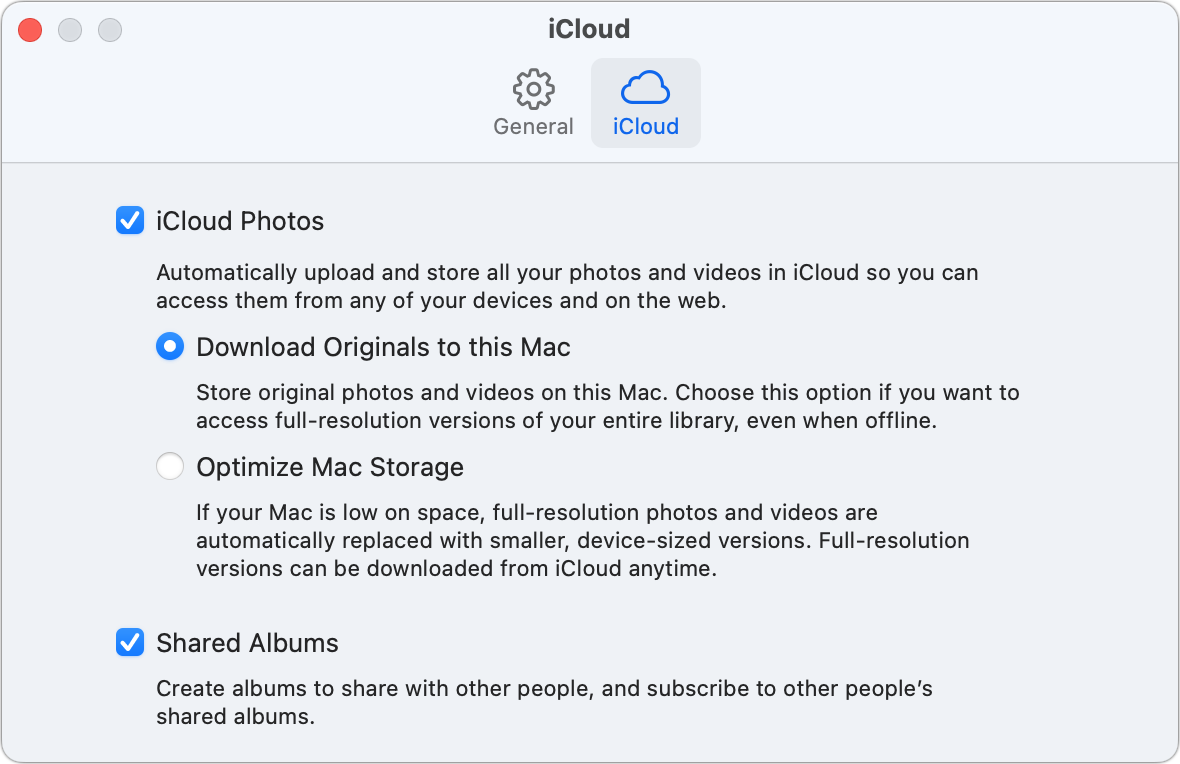In macOS you can choose to optimize your usage of local storage by having your Mac automatically offload files that it is already syncing to iCloud Drive, iCloud Photos, and other services. The logic is that you might have limited local storage and dozens to hundreds of gigabytes of data you don’t need access to all the time, such as filed documents and photos from years past. You want them on-demand—with an active internet connection—but not necessarily filling your drive.
However, there’s a big catch: so-called optimized files are backed up only at iCloud. Because there’s only a local placeholder for the synced file, Time Machine, third-party sync and backup software, and internet-hosted backup services cannot make copies.
You might decide that’s okay! You trust the integrity of Apple’s data centers and the quality of their operations. While Apple doesn’t offer insight into how they protect your data, it’s definitely the case that the copy has multiple copies of your data stored in three or more different locations to avoid the risk of data loss due to hardware, fire or other accident, natural disaster, or a cyber or real-world attack.
Even if that’s enough for you, still read on to be sure your backup strategy is effective.
The drawbacks of relying on iCloud-only offloaded files
Making iCloud your only copy for synced data that’s pushed off your drives or devices for optimization has drawbacks:
- Lose access to iCloud: You could be locked out, have equipment stolen, have your account hijacked, or be blocked by Apple, and, despite the lack of legitimacy involved, never recover access. (You can mitigate some of this risk by enabling iCloud Recovery Data Service.)
- Delete items and don’t realize it until it’s too late: iCloud doesn’t retain deleted items for long. Both iCloud Drive and iCloud Photos have Recently Deleted collections (a folder and an album, respectively), but their contents empty automatically after 30 days.
- Time to restore: Unless you have a high-speed, uncapped, no-overage-charges internet connection, if you have to restore your files by resyncing to iCloud with a new Mac or a new drive, it could take days or weeks with hundreds of gigabytes of data. With a local Time Machine volume, it might be hours.
- Inexplicable failures: One Macworld reader recently reported that their daughter lost a number of music files, despite having Sync Library enabled in Music and an iTunes Match subscription. Even with Apple’s help, they were able to restore only a fraction of the lost files, despite having experienced going through this before: in a previous failure, all files were restored. It’s unclear what happened, but these synced files so far remain missing.
You can “game” optimization in one specific way, though you can’t guarantee it will work to back up all the files you want: the most recent files you create or modify will almost always be backed up quickly by Time Machine or an online service that frequently checks for modified files. That will leave you with an archived copy before macOS could decide to remove the file for optimization.
The best way to ensure you have a full backup with this method is to not enable any optimization until you have your first complete backup performed on all the services you plan to use.
This strategy won’t work if you have to reset a Time Machine backup or other archive, or if you swap among Time Machine volumes to keep an onsite and offsite set. In those cases, you have to disable optimization to create a fresh complete starting backup, which may take a lot of time and bandwidth to achieve.
Manage optimization controls

If you want to enable or disable optimization, here’s where you can find the controls in macOS:
- In System Preferences > Apple ID > iCloud (Catalina or later) or in the iCloud preference pane (Mojave or earlier), Optimize Mac Storage controls iCloud Drive storage management.
- In the Photos app in Photos > Preferences > iCloud, you can enable iCloud Photos, but opt between “Download Originals to this Mac” and “Optimize Mac Storage.” I have a desktop and laptop Mac, and added a 1TB external lower-speed SSD for my Photos library specifically to always retain a full-resolution local copy; see this column. (You can choose a similar option in iOS/iPadOS in Settings > account name > iCloud > Photos, but the backup process is quite different.)
- In the Music app, go to Music > Preferences > General to opt to Sync Library. If you have an active Apple Music subscription or iTunes Match subscription, any unique songs stored on your Mac will be synced (and potentially matched) to iCloud, too. (This 2015 column on syncing music with iCloud remains helpful.)

How Apple could help
Apple could alleviate some of the drawbacks I mentioned without putting our data or our privacy at risk:
- Integrate iCloud and local Time Machine backups so that a synced file, image, video, or song was validated as backed up on a Time Machine volume and marked to prevent deletion from that volume before it was removed from local storage.
- Create a backup framework for developers to offer the same feature in their software.
- Allow internet-backup services to connect directly to our iCloud storage with appropriate authorization and authentication to backup files exclusively stored in iCloud after being “optimized.”
This Mac 911 article is in response to a question submitted by Macworld reader Joe.
Ask Mac 911
We’ve compiled a list of the questions we get asked most frequently, along with answers and links to columns: read our super FAQ to see if your question is covered. If not, we’re always looking for new problems to solve! Email yours to mac911@macworld.com, including screen captures as appropriate and whether you want your full name used. Not every question will be answered, we don’t reply to email, and we cannot provide direct troubleshooting advice.




